home >> online collections >>
event archive >> botkin lecture archive >> 2004
botkin lectures
2004 Botkin Lectures
Online Archives of Past Benjamin A. Botkin Folklife
Lectures
All of the materials from the Botkin Lectures are available to visitors
in the Folklife Reading Room. Selected materials will be made available
online as digital versions are available and as permissions from the
authors can be obtained.
The PDF files of the event flyers on this page require Adobe
Acrobat Reader (free from Adobe).
Thursday October 21,
2004 at Noon
Mumford Room, 6th Floor Madison Building
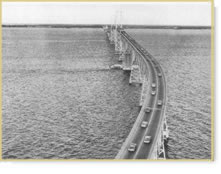 "From
Bridge to Boardwalk, an Audio Journey Across Maryland's Eastern Shore" an
illustrated lecture based on the CD and Book presented by Douglas Manger,
folklorist at the Mid Atlantic
Arts
Foundation, Tatiana Irvine, independent radio producer, and Elaine Eff,
folklorist at the Maryland Historical Trust. "From
Bridge to Boardwalk, an Audio Journey Across Maryland's Eastern Shore" an
illustrated lecture based on the CD and Book presented by Douglas Manger,
folklorist at the Mid Atlantic
Arts
Foundation, Tatiana Irvine, independent radio producer, and Elaine Eff,
folklorist at the Maryland Historical Trust.
Read
the event flyer essay (PDF 2 pages, 1157kb)
Assembled by folklorists and community scholars who know
the Eastern Shore intimately, the CD and booklet From Bridge to Boardwalk includes
two hours of interviews with some of the Shore's
most interesting
and
revealing
people,
plus music tracks never before available on disc. A separate Booklet
features a dozen essays on regional topics, photographs, and tips for
learning more about Maryland's Eastern Shore. Contributors to this important
work presented an illustrated lecture on the unique culture of the
Eastern Shore.
Photo: The Chesapeake Bay Bridge-Tunnel, Maryland.
Monday September 20, 2004 at Noon
Dining Room A, 6th Floor Madison Building
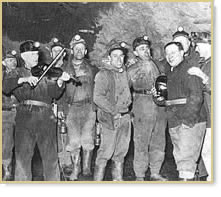 "The
Lore of America's Coal Miners: A Fresh Look at the George Korson Collection" -
presented by Angus Kress Gillespie, Professor of American
Studies, Rutgers - The
State University of New Jersey "The
Lore of America's Coal Miners: A Fresh Look at the George Korson Collection" -
presented by Angus Kress Gillespie, Professor of American
Studies, Rutgers - The
State University of New Jersey
Read
the event flyer essay (PDF 2 pages, 1183kb)
Folklorist and journalist George Korson began collecting
the songs and stories of anthracite miners in Pennsylvania in 1924, when
labor conflicts were a prominent part of American culture. What began
as a newspaper assignment became a life-long passion resulting in books,
recordings, fieldwork documentation. Celebrating the gift of an archival
collection
of George Korson's work, including
manuscripts,
photographs,
sound recordings,
and books
by Kings
College
in Wilkes-Barre Pennsylvania, this lecture by Korson biographer Angus
K. Gillespie paid tribute to the life and work of George Korson. Professor
Gillespie briefly reviewed Korson's accomplishments; traced the chain
of custody of his papers; assessed Korson's place in intellectual history;
and reported on the status of occupational folklore scholarship today.
Photo: George Korson, cap in hand, listens as James Muldowney
plays the fiddle in the Newkirk Tunnel Mine during the 1946 Library of
Congress
field trip.
More about the work of Professor Gillespie may be found
on his web site via Rutgers University: Angus
Kress Gillespie
Recordings from the George Korson Collection available
from the Library of Congress Sales Shop (shop online):
Songs
and Ballads of the Anthracite Miners (Rounder CD 1502)
This CD features the "minstrels of the mine patch" in
the Pennsylvania anthracite region. Originally recorded and edited
by George Korson in 1946-47.
Songs
and Ballads of the Bituminous Miners (Rounder CD 1522)
A companion to Songs and Ballads of the Anthracite Miners, this album
of mining
songs, documented in 1940 by "folklorist
of the coal fields" George Korson, presents the performances of bituminous
(soft coal) miners, from the time before automation drastically changed
the way their work was done.
Tuesday, August 31, 2004 at Noon
Dining Room A, 6th Floor Madison Building
 "From Patent Medicines to Patents for Indigenous
Knowledge -- Material and Spiritual Economies" —
an illustrated lecture by Margaret Kruesi, American Folklife Center "From Patent Medicines to Patents for Indigenous
Knowledge -- Material and Spiritual Economies" —
an illustrated lecture by Margaret Kruesi, American Folklife Center
Read the event
flyer essay
People's stories of their illness
and healing experiences preserve first-hand knowledge of illness and
address anxiety
about health within the family and the broader community. In many respects,
patent medicines of
150 years ago and the search for new drugs to be patented in the twenty-first
century have little in common. Now, specific biochemical compounds and
genetic materials are sought after for patents. But in both cases, the
first-hand knowledge of native people and their narratives about healing
experiences may play crucial roles in access to these medicines, and
in both cases, issues of the exploitation of various groups are at stake.
This illustrated talk explored the marketplaces for patent medicine in
the nineteenth and twentieth centuries; the material and spiritual exchanges
that take place in illness and healing narratives and rituals in contemporary
societies; and reflected on the current economic interest in "indigenous
knowledge" as it is related to traditional knowledge and healing.
Photo: Louden & Co. Indian Expectorant label
Friday July 16, 2004 at Noon
West Dining Room, 6th Floor Madison Building
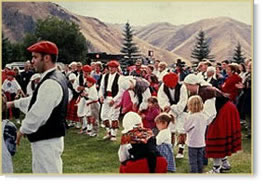 Basque
Culture in the Western United States —
an illustrated lecture by Maria Carmen RA. Gambliel, Director Folk and
Traditional Arts Program, Idaho Commission on the Arts Basque
Culture in the Western United States —
an illustrated lecture by Maria Carmen RA. Gambliel, Director Folk and
Traditional Arts Program, Idaho Commission on the Arts
Read the event flyer essay
(PDF)
The first Basque pioneers came to the United States in the
1860s to escape the restricted economy and military conscription of in
the Spanish and French Basque provinces. After two generations their Amerikanuak descendents
looked back to the Basque country and the culture of their extended families
to find out what it really meant to be Basque.
Photo: Basque performers
at an Idaho festival. Photo by Maria Carmen Gambliel. Part of the documentation
in Idaho Local
Legacies projects.
Wednesday June 16, 2004 at Noon
Room 119, Thomas Jefferson Building
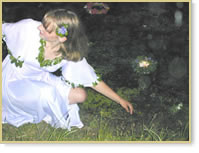
Ivan Kupalo: Ritual in Post-Soviet Ukraine —
an Illustrated lecture by Dr. Natalie Kononenko, Professor of Slavic Languages,
Literatures, and Folklore at the University of Virginia.
Read
the event flyer essay (PDF 2 pages, 891kb)
Ivan Kupalo, the mid-summer celebration of St. John the
Baptist, an ancient festival with deep pre-Christian roots, is a ritual
that virtually disappeared during the Soviet period, but is now celebrated
across Central Ukraine. Natalie Kononenko discussed the re-emergence
of this ritual in the Ukraine and its importance in Ukrainian cultural
identity.
Photo: a young woman places a wreath in water as part of
an Ivan Kupalo ritual
Tuesday May 25, 2004
West Dining Room, 6th Floor Madison
Building
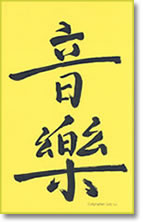 Eight
Sounds of Chinese Musical Instruments — an
illustrated lecture by Nora Yeh, Ethnomuisicologist, American Folklife
Center Eight
Sounds of Chinese Musical Instruments — an
illustrated lecture by Nora Yeh, Ethnomuisicologist, American Folklife
Center
Read the
event flyer essay (PDF 2 pages, 365kb)
 This lecture traced the history and development of traditional
Chinese music and musical instruments, with illustrations of the sounds
of instruments and pictures of
the instruments
themselves dating from 2100 BCE to the present. This lecture traced the history and development of traditional
Chinese music and musical instruments, with illustrations of the sounds
of instruments and pictures of
the instruments
themselves dating from 2100 BCE to the present.
Nora Yeh, currently an archivist at the Archive of Folk
Culture, American Folklife Center, received both her MA and PhD from UCLA.
She has taught
at UC Santa Barbaa; served as a panelist for NEA and as a consultant for
the governments of China and Taiwan; received awards to conduct research
on East and Southeast Asia; and contributed to publications on Chinese
and Asian American performing arts.
Tuesday, April 27, 2004 at noon
Mumford Room, 6th Floor Madison Building
 "Yodel-Ay-Ee-Ooo: The Secret History of Yodeling
Around the World" —
a lecture by Bart Plantenga based on his recent book. Featuring yodelers
Randy Irwin and Cathy Fink "Yodel-Ay-Ee-Ooo: The Secret History of Yodeling
Around the World" —
a lecture by Bart Plantenga based on his recent book. Featuring yodelers
Randy Irwin and Cathy Fink
Read the event
flyer essay (PDF 2 pages, 888kb)
Bart Plantenga's Yodel-Ay-Ee-Oooo: The Secret History
of Yodeling Around the World (2004) looked at yodeling as a global
phenomenon. Bart Plantenga is the author of cultural, musical, and historical
journalism, fiction, and non-fiction.
Photo: Yodel-Ay-Ee-Ooo book cover
Tuesday March 23, 2004 at noon
Dining Room A, 6th Floor of the Madison Building
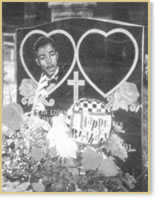 "Giving
a Voice to Sorrow: Creative Responses to Death" — an illustrated
lecture presented by Ilana Harlow of the American Folklife Center. "Giving
a Voice to Sorrow: Creative Responses to Death" — an illustrated
lecture presented by Ilana Harlow of the American Folklife Center.
Read
the event flyer essay (PDF 2 pages, 1196kb)
Many traditional responses to death involve creativity.
This is evident in the stories, music, and art connected to funerary rites.
In our time,
in addition to these traditions ands sometimes in lieu of them, it has
become increasingly common for mourners and the terminally ill to craft
personal rituals and memorial art in response to death. Folklorist Ilana
Harlow presented illustrations of this trend from her fieldwork and explored its significance.
Photo: Gravestone with a portrait of a young man decorated
with flowers and a birthday balloon.
Wednesday February 25, 2004 at noon
Dining Room A, 6th Floor of the Madison Building
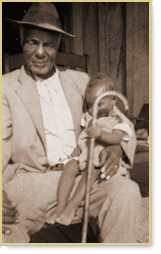 "Voices
from the Days of Slavery: Former Slaves Tell Their Stories" presented
by John Barton, American Folklife Center. "Voices
from the Days of Slavery: Former Slaves Tell Their Stories" presented
by John Barton, American Folklife Center.
Read
the event flyer essay (PDF 2 pages, 988kb)
Go
to the online presentation: "Voices from the Days of
Slavery"
"Voices from the Days of Slavery: Former Slaves Tell
Their Stories"" is
a new American Memory presentation that provides the opportunity to listen
to
former slaves
describe
their
lives. These recorded interviews, conducted between 1932 and 1975, capture
the recollections of twenty-three people born between 1823 and the early
1860s and known to have been former slaves.
Photo: Bob Ledbetter, age 72 or 73, interviewed by John Lomax in Oil City,
Louisiana, October, 1940.
Thursday, January 22, 2004 at noon
Dining Room A, 6th floor of the James Madison Building
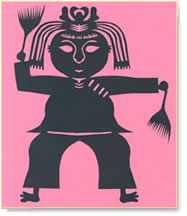 "Chinese
Folk Art Today" — an
illustrated lecture by Xianrang Yong, Artist and professor emeritus of
the Bejing Central Academy of Fine Arts "Chinese
Folk Art Today" — an
illustrated lecture by Xianrang Yong, Artist and professor emeritus of
the Bejing Central Academy of Fine Arts
Read
the event flyer essay (PDF 2 pages, 715kb)
Xianrang Yong was born in Yangma
Island, Muping, Shandong Province, Peoples Republic of China in 1930.
He spent his early years in Inchon, Korea and
returned to China to earn a diploma in painting from the Bejing National
Arts Academy in 1952. In 1880 he became a founding member of the Central
Academy of Fine arts Folk Arts Department, for which he served as Chairman
until 1990. In his lecture, Professor Yong focused on the origin,
development, and current state of Chinese folk arts. (Professor Yong changed
the spelling of his name from Yang to Yong. The flyer text gives his name
as Yang.)
Image: Chinese paper cut
|

 "From
Bridge to Boardwalk, an Audio Journey Across Maryland's Eastern Shore"
"From
Bridge to Boardwalk, an Audio Journey Across Maryland's Eastern Shore"  "The
Lore of America's Coal Miners: A Fresh Look at the George Korson Collection"
"The
Lore of America's Coal Miners: A Fresh Look at the George Korson Collection"  "From Patent Medicines to Patents for Indigenous
Knowledge -- Material and Spiritual Economies"
"From Patent Medicines to Patents for Indigenous
Knowledge -- Material and Spiritual Economies"  Basque
Culture in the Western United States
Basque
Culture in the Western United States
 Eight
Sounds of Chinese Musical Instruments
Eight
Sounds of Chinese Musical Instruments
 "Yodel-Ay-Ee-Ooo: The Secret History of Yodeling
Around the World"
"Yodel-Ay-Ee-Ooo: The Secret History of Yodeling
Around the World" "Giving
a Voice to Sorrow: Creative Responses to Death"
"Giving
a Voice to Sorrow: Creative Responses to Death" "Voices
from the Days of Slavery: Former Slaves Tell Their Stories"
"Voices
from the Days of Slavery: Former Slaves Tell Their Stories"